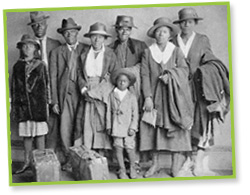A Bronzeville Story
Elementary: Grades 3–4
Background Information
The Great Migration and the Chicago Defender
The Great Migration, a long-term movement of African Americans from the South to the urban North, changed Chicago and other northern cities between 1916 and 1970. Chicago attracted more than 500,000 of the approximately 7 million African Americans who left the South during these decades. Before this migration, African Americans were 2 percent of Chicago's population; by 1970 they were 33 percent.
A newspaper called the Chicago Defender was an important source of information for African American readers who were thinking about moving. It encouraged readers to seek a better life and better jobs in the North. It showed pictures of the best schools, parks, and houses in Chicago next to pictures of the worst conditions in the South. The Chicago Defender is considered one of history's most important newspapers because it told the truth about prejudice in America and helped to convince so many people to move North.
Bronzeville
This African American neighborhood on the South Side of Chicago was originally called the "Black Belt" because it was a narrow strip of land, shaped like a belt. Knowing many neighborhood citizens disliked the name, Chicago Defender publisher Charles Browning promoted the nickname Bronzeville through his newspaper. His name quickly caught on, and the neighborhood became famous.
From the early 1900s through the 1950s, the Great Migration caused the population of Bronzeville to grow larger. African Americans faced unfair treatment even in a northern city, such as Chicago. Black people were prevented from buying property outside of the Bronzeville neighborhood, and this caused overcrowding and poor housing conditions. Despite these challenges, Bronzeville was the home to many important black-owned businesses and became the place that everyone wanted to visit to hear the most popular jazz and blues music.
Source: The Electronic Encyclopedia of Chicago
Downloads (pdf)


